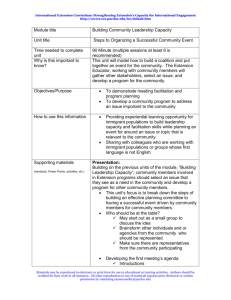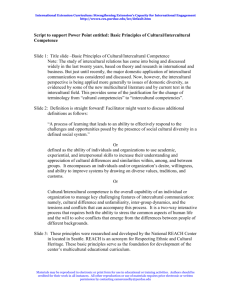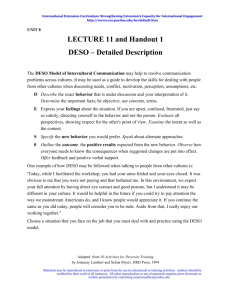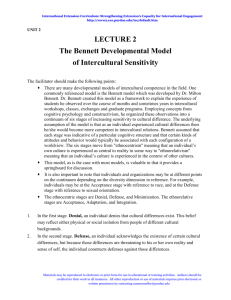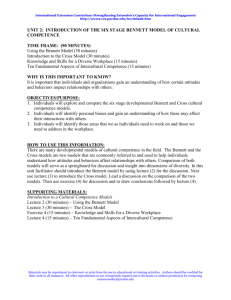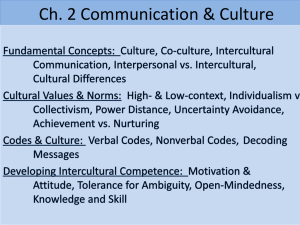Text
advertisement
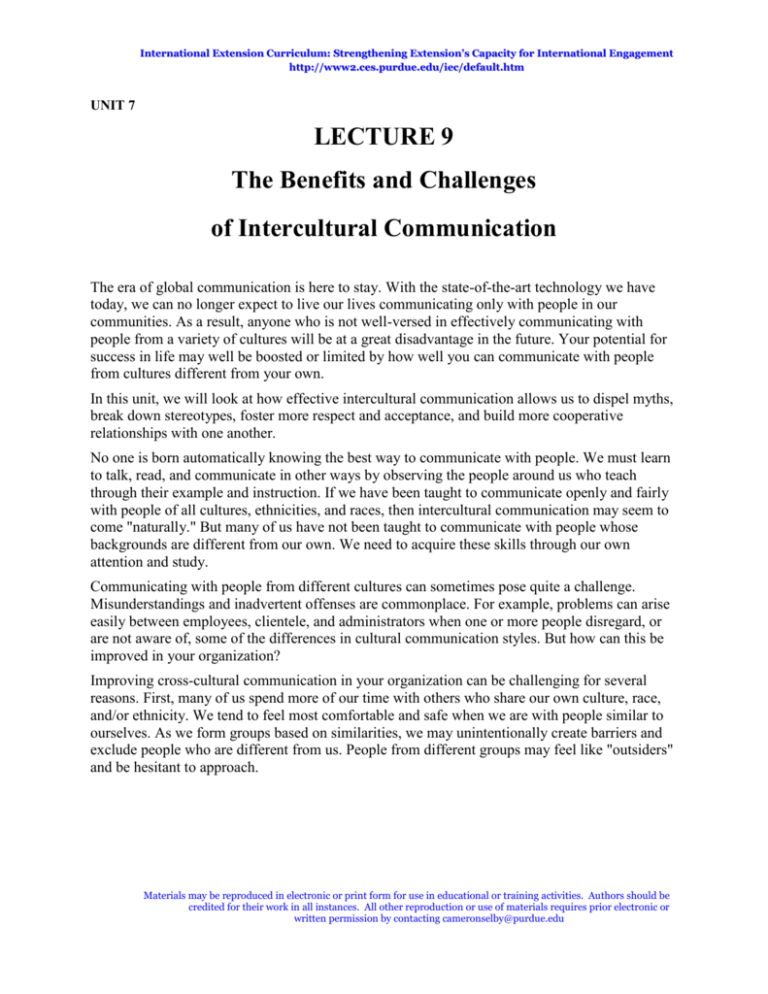
International Extension Curriculum: Strengthening Extension’s Capacity for International Engagement http://www2.ces.purdue.edu/iec/default.htm UNIT 7 LECTURE 9 The Benefits and Challenges of Intercultural Communication The era of global communication is here to stay. With the state-of-the-art technology we have today, we can no longer expect to live our lives communicating only with people in our communities. As a result, anyone who is not well-versed in effectively communicating with people from a variety of cultures will be at a great disadvantage in the future. Your potential for success in life may well be boosted or limited by how well you can communicate with people from cultures different from your own. In this unit, we will look at how effective intercultural communication allows us to dispel myths, break down stereotypes, foster more respect and acceptance, and build more cooperative relationships with one another. No one is born automatically knowing the best way to communicate with people. We must learn to talk, read, and communicate in other ways by observing the people around us who teach through their example and instruction. If we have been taught to communicate openly and fairly with people of all cultures, ethnicities, and races, then intercultural communication may seem to come "naturally." But many of us have not been taught to communicate with people whose backgrounds are different from our own. We need to acquire these skills through our own attention and study. Communicating with people from different cultures can sometimes pose quite a challenge. Misunderstandings and inadvertent offenses are commonplace. For example, problems can arise easily between employees, clientele, and administrators when one or more people disregard, or are not aware of, some of the differences in cultural communication styles. But how can this be improved in your organization? Improving cross-cultural communication in your organization can be challenging for several reasons. First, many of us spend more of our time with others who share our own culture, race, and/or ethnicity. We tend to feel most comfortable and safe when we are with people similar to ourselves. As we form groups based on similarities, we may unintentionally create barriers and exclude people who are different from us. People from different groups may feel like "outsiders" and be hesitant to approach. Materials may be reproduced in electronic or print form for use in educational or training activities. Authors should be credited for their work in all instances. All other reproduction or use of materials requires prior electronic or written permission by contacting cameronselby@purdue.edu International Extension Curriculum: Strengthening Extension’s Capacity for International Engagement http://www2.ces.purdue.edu/iec/default.htm Second, breaking out of our homogeneous groups takes effort. The more accustomed we are to being with people whom we perceive to be like us, the more effort it takes to reach out to others whom we perceive to be different from us. Once divisions are established along cultural, ethnic, and racial lines, it takes a great deal of courage and determination to communicate across these lines. We may encounter feelings of discomfort as we reach out to others, or we may fear that others from within our group will disapprove of including outsiders. Without a strong commitment to overcoming differences, we may give up when obstacles to communication arise. Third, we may be afraid that we will have a negative experience with the very people we are trying to reach out to. We may fear that our efforts to understand and be understood will be rejected, or that we will offend someone or be offended. If we have had negative experiences with a member of another cultural, racial, or ethnic group in the past, we may generalize our fears, assuming that we will always experience difficulty in communicating with individuals of that group. We may be unwilling to examine our part in communication barriers, instead blaming all communication difficulties on the other party. At some point, however, if we truly desire to reach out to people, we must set aside our fears, give people the benefit of the doubt, take responsibility for our own part in communication struggles, and share ourselves with others. The risks of communicating across cultures are real; there is always the possibility that we will not be understood in the way we intend. But the potential benefits of trying to reach across cultural boundaries are well worth the effort—and the risks of not trying are great. DISCUSSION QUESTIONS 1. What do you believe are the primary reasons people of different cultures, races, and ethnicities miscommunicate and misinterpret with one another? 2. What is the role of practice in learning intercultural communication skills? 3. How can good intercultural skills help you in your future? 4. How did your parents or guardians learn about people of different cultures? (You may wish to interview them to find out.) 5. How have you learned to communicate with people of other cultures? 6. What do you think is the greatest challenge to intercultural communication in your organization? Materials may be reproduced in electronic or print form for use in educational or training activities. Authors should be credited for their work in all instances. All other reproduction or use of materials requires prior electronic or written permission by contacting cameronselby@purdue.edu International Extension Curriculum: Strengthening Extension’s Capacity for International Engagement http://www2.ces.purdue.edu/iec/default.htm UNIT 7 LECTURE 10 KEY ISSUES IN INTERCULTURAL COMMUNICATION Effective communication is key in developing strong and positive relationships with people. Unfortunately, it is not easy and it requires consistent attention, energy, and skills. Communication with someone who is culturally different from you can be challenging. The following key issues in effective intercultural communication are important to consider as you meet and communicate with people of different cultures. There are some basic differences in the ways people of different cultures communicate, such as through the different use of words, voice pitch, and nonverbal (body language). Within each culture, there are individual differences in the way people communicate. In communicating with someone of a different culture, it is important to make sure you consider the person's cultural background. You need to be flexible in your communication style if you want to relate positively to people of different cultures. There are limits to how much someone should try to shift his or her communication style to be like someone who is culturally different. Openness, caring, and mutual respect for the dignity of individuals are essential qualities for effective communication, regardless of cultural differences. There are great advantages throughout your life to being knowledgeable, respectful, and open toward others who are culturally different from you. Materials may be reproduced in electronic or print form for use in educational or training activities. Authors should be credited for their work in all instances. All other reproduction or use of materials requires prior electronic or written permission by contacting cameronselby@purdue.edu International Extension Curriculum: Strengthening Extension’s Capacity for International Engagement http://www2.ces.purdue.edu/iec/default.htm UNIT 7 EXERCISE 8A Intercultural Communication Styles Objective: To help participants appreciate the fact that their own communication styles, though individual, are influenced by culture. To recognize the difficulty of having to communicate in a setting in which the rules are unfamiliar. Time: 45 minutes Materials: • Exercise 8A (instructions should be cut into strips) for each participant • Flipchart and marker Procedure: 1. Make enough copies of Exercise 8A and cut so each participant receives one instruction, A, B, C or D. 2. After giving each participant one strip, instruct participants not to share their rules with anyone. 3. Ask participants to pair up, preferably all A's should be talking to B's and C's talking to D's. (If possible have them pair up with someone they don't know.) 4. Ask the pairs to talk to each other for two minutes, carefully following the instructions they received. Their task is to find out two new things about their partner. Debriefing: 1. Ask participants if they found the exercise easy and solicit their first reactions to the assignment. 2. List their responses on the flipchart. 3. Have one participant from each group (A,B,C,D) read his/her rules aloud to the group. As the rules are read, list the following communication issues on the flipchart: a. Eye contact and the showing of emotion b. Distance and gestures Materials may be reproduced in electronic or print form for use in educational or training activities. Authors should be credited for their work in all instances. All other reproduction or use of materials requires prior electronic or written permission by contacting cameronselby@purdue.edu International Extension Curriculum: Strengthening Extension’s Capacity for International Engagement http://www2.ces.purdue.edu/iec/default.htm c. Loudness and interruptions; initiating conversation and personal questions d. Softness and no interruptions; not initiating conversation or asking questions 4. Ask how the participants interpreted the behavior of their partners during the exercise. (For example, the person whose partner looked away felt that his/her partner couldn't be trusted, wasn't interested, or perhaps was bored.) It is important to recognize that there is a "mainstream" American communication style and that many different cultures bring with them their own rules and communication styles which are different. Facilitator's Notes: The more a person understands differences in communication styles, the better communication can become. You may also suggest that matching styles can further positive communication across cultures. Materials may be reproduced in electronic or print form for use in educational or training activities. Authors should be credited for their work in all instances. All other reproduction or use of materials requires prior electronic or written permission by contacting cameronselby@purdue.edu International Extension Curriculum: Strengthening Extension’s Capacity for International Engagement http://www2.ces.purdue.edu/iec/default.htm EXERCISE 8B Intercultural Communication The following instructions should be photocopied and cut into strips. Enough copies should be made so that each participant can be given one strip. Group A Instructions • Avoid eye-contact when speaking to your partner. • Do not show any emotion or react to your partner when he/she is speaking. Group B Instructions • Stand about six inches closer to your partner than you normally would. • Use gestures often when you are speaking. Group C Instructions • Speak louder than you normally would and interrupt your partner fairly frequently. • Initiate conversation by asking a lot of questions (including personal ones). Group D Instructions • Speak softer than you normally would and don't interrupt your partner. • Don't initiate conversation or ask questions. Adapted from 50 Activities/or Diversity Training by Jonamay Lambert and Selma Myers. HRD Press, 1994 Materials may be reproduced in electronic or print form for use in educational or training activities. Authors should be credited for their work in all instances. All other reproduction or use of materials requires prior electronic or written permission by contacting cameronselby@purdue.edu
